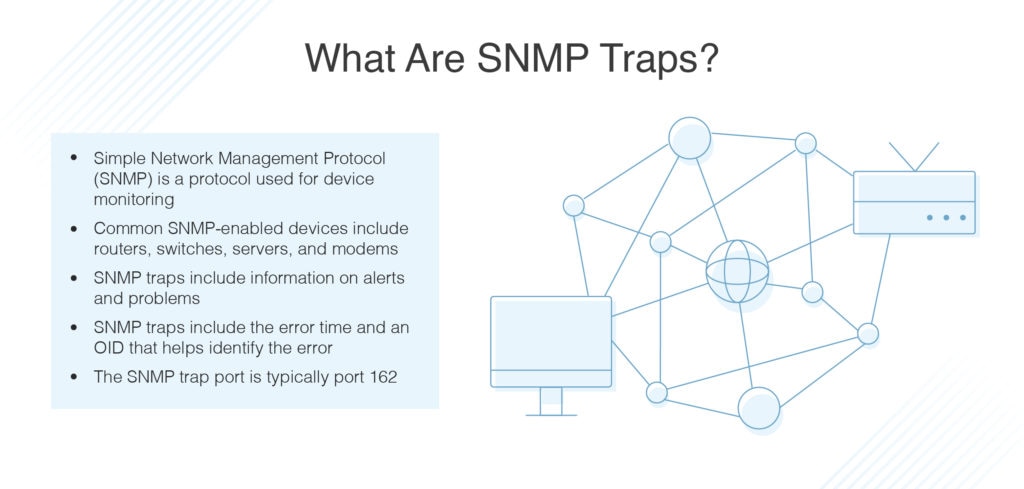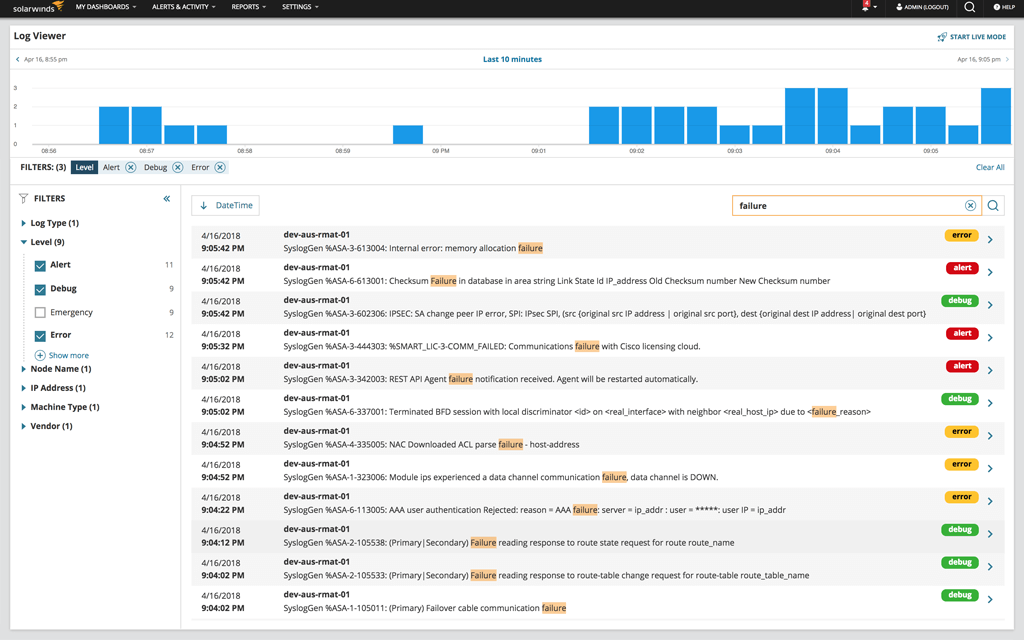How To Send Snmp Trap From Windows
Devices enabled for using the Simple Network Management Protocol (SNMP) send out diverse SNMP messages to convey information. SNMP traps are a particular kind of message including information on alerts and problems. It's important to be able to view and apply these pieces of information when managing your data ecosystem, equally they provide critical device information on metrics that could majorly touch functioning and applications.

Using tools to view, translate, and act on SNMP traps can be a good approach. For example, SolarWinds ® Log Analyzer helps y'all streamline how y'all utilise SNMP traps for network monitoring, and offers both log viewing and real-time troubleshooting tools.
- What Is an SNMP Trap?
- How to View SNMP Traps
- How to Cull a Tool
What Is an SNMP Trap?
The first thing you might be asking is "What is SNMP?" Traps are a role of the way SNMP functions, but allow'southward begin with SNMP in general. SNMP is a widely-used protocol for network monitoring processes. When devices have SNMP enabled, data near those devices can be collected and analyzed to ensure they're performing well. Commonly SNMP-enabled devices include routers and switches, servers, workstations, printers, and modems.
There are three parts of SNMP allowing it to function: a primal SNMP manager, a device agent, and a direction information base of operations (MIB). The device agent is what allows you to turn SNMP on or off, and the MIB is the way in which the device information is structured and made accessible. The device agent also sends out signals to the manager.
The SNMP manager monitors devices to check what signals the device agent is sending out. In virtually cases, SNMP traps are one of these signals, or messages, SNMP-enabled devices send to the SNMP director, particularly to warning an of import event has occurred, such equally a device overheating. This is essentially a warning or emergency message, so the manager tin run into a problem needs to be fixed.
An SNMP trap port is the port at which the manager receives the traps. This port is typically fix every bit port number 162. However, you lot can change this port if necessary, and it may also differ depending on the SNMP manager y'all're using.
I of the complicated things most SNMP traps is they're not always effective at alerting you lot when major errors have occurred. For instance, sometimes the device agent will send out an SNMP trap for a minor consequence and miss a major trouble capable of bringing your unabridged network down. For instance, if the device experiences a fatal issue shutting down the entire device, the SNMP agent tin can no longer work either (and no SNMP trap will be sent out).
SNMP traps are sent out in a particular format, showing a time, an identifier, and a value. The time shows when the error occurred. The identifier is from the MIB and is called an "OID," also known every bit an Object Identifier. The OID represents an chemical element of the device being monitored, such as temperature, CPU office, or memory (or fifty-fifty whether the printer ink is running low). These OIDs tin can help you lot to pinpoint the trouble.
This information is disquisitional when you're monitoring a large network where a single device failure can cause a cascade of issues.
How to View SNMP Traps
Ane of the first things you need to sympathise about SNMP traps is if you aren't viewing them or using them to inform your network monitoring approach, you're missing a vital piece of the puzzle. If you're wondering how to view SNMP on Windows, the best manner is by using automated tools, but information technology'southward possible to configure SNMP manually on some newer Windows devices, and it'southward already installed on older systems. To turn on SNMP for many Windows devices, you tin admission the Programs and Features section of the Control Panel. On Windows Server, you lot tin can install the SNMP Service in the Add Roles and Features Wizard. On the Agent tab, yous can bank check off all the services to incorporate SNMP information.
Even so, to hands collect and view information from across devices, your best bet is a flexible tool compatible with various device types and vendors. Whatsoever tool you're using will likely accept a specific dashboard where you can view SNMP traps as a log type. For example, some tools will have a dedicated application only displaying SNMP traps every bit an output. Other tools volition require you to put in a command such as "view SNMP traps." Some tools will have a process requiring configuration before you can view the traps, and so on. For your usability purposes, y'all should consider how the tool you desire to apply allows you to view the traps, and what format it displays them in. Your all-time bet is a tool that takes a user-friendly approach, but still allows for in-depth visibility if you need to investigate an issue.
There are many network monitoring tools out there capable of helping you view and use SNMP, and there are several different types of tools available. Yous also demand to know how to check SNMP traps using whatever tool yous choose. Choosing an intuitive and piece of cake-to-use piece of software makes a big difference in the troubleshooting process, as using a difficult tool with a steep learning bend can stop up slowing you downwards.
Whether for an enterprise or smaller business setting, one of the best tools I recommend is SolarWinds Log Analyzer. Log Analyzer acts as an SNMP trap receiver and can discover, search through, and display log files for a full overview of the events happening in your IT environs.
Log Analyzer supports several unlike sources of logs, including syslog, SNMP traps, Windows, VMware events, and Windows awarding log files. This ways you can view SNMP traps in the greater context of your entire network functioning and effect data, which can provide a complete flick of whatsoever functioning bug or problems in your network more generally. The broad back up also ways yous tin see these files in a centralized location, which makes the process faster and easier.

With regard to SNMP traps specifically, Log Analyzer doesn't act as an SNMP manager, and doesn't process MIBs. Rather, it listens for broadcasted trap messages. This style, you get the most vital data without any additional details you may not need. If you're wondering how to view SNMP traps in Log Analyzer, you tin view them through the "Trap Viewer" application and configure trap-specific alerts to permit you know when an SNMP trap is sent out.
1 of my favorite things near Log Analyzer is you can search through and filter the logs, which means if you're looking for something specific or only desire to look at one blazon of log, or logs during one time catamenia, yous can easily do so. This leads to faster troubleshooting and much more refined approaches to alerts and problems. This efficiency tin can lead to less downtime and reduce the touch on terminate users. This unproblematic tool is piece of cake to become up and running and is excellent for troubleshooting specifically.
Yous can also integrate Log Analyzer with the Orion®Platform, which is a SolarWinds solution allowing you to combine and integrate multiple SolarWinds products. This ways if you want a broader network monitoring tool, or if y'all want to monitor IP addresses, VOIP, user behavior, web operation, databases, or virtual machines, you tin combine products to create a centralized platform with everything in one place. You lot tin try out Log Analyzer for up to 30 days for gratis.
In addition to Log Analyzer, there are many other paid or costless tools you lot tin can bank check out, but be have caution when using free or open-source tools in a professional person environs. They often don't include support packages and may not integrate well with other tools or let for expanded functionality.
Source: https://www.dnsstuff.com/snmp-traps-explained-how-to-view
Posted by: gainesfreace.blogspot.com

0 Response to "How To Send Snmp Trap From Windows"
Post a Comment